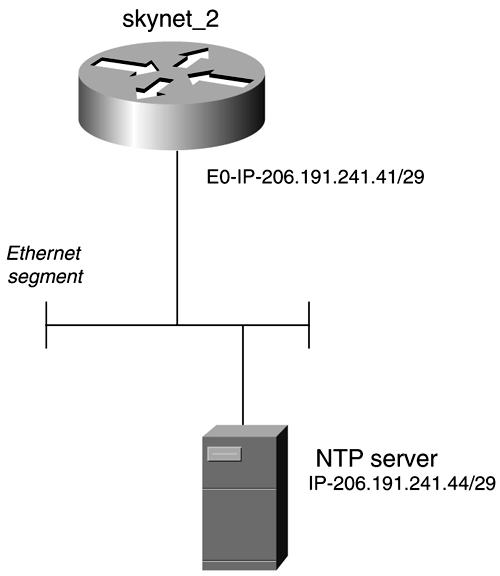CCIE Practical Studies, Volume I
| < Free Open Study > |
Configuring the Simple Network Time Protocol (SNTP)
On smaller routers that do not >support NTP, such as the Cisco 100x series, the 80x series, and other lower-end routers, you can deploy SNTP. However, SNTP lacks some of the enhanced features of NTP: It cannot be an NTP server, and it provides no authentication and statistics mechanisms. SNTP can be configured in two ways, much like NTP:
If both methods are configured, the router accepts a tie from a broadcast server, but it prefers time from the static server, assuming that the stratum levels are equal. To configure SNTP on the smaller Cisco platforms, use the following global commands:
The example in this section uses a Cisco 804, called skynet_2, and an NTP server on its LAN interface, as illustrated in Figure 17-6. Figure 17-6. SNTP Configuration Topology
To configure this router to receive updates from an unknown source, simply add the sntp broadcast client configuration command. You will also add the appropriate time zone for the U.S. Central time and set daylight saving time. Example 17-14 demonstrates this process. Example 17-14 Configuring SNTP on a Cisco 804 Router
skynet_2(config)# sntp broadcast client skynet_2(config)# clock timezone CST -6 skynet_2(config)# clock summer-time CDT recurring skynet_2(config)# exit skynet_2# show sntp SNTP server Stratum Version Last Receive 206.191.241.44 14 3 00:00:39 Synced Bcast Broadcast client mode is enabled. skynet_2# show clock 14:12:45.116 CDT Tue Jul 11 2000 Note that the SNTP has synchronized to the server 206.191.241.44 with a stratum 14, without statically configuring it. The show clock command shows the clock to be in daylight saving time. |
| < Free Open Study > |
